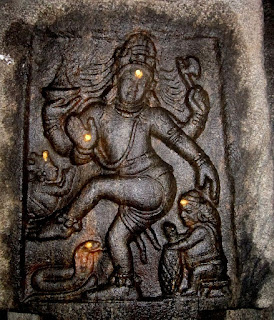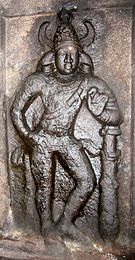ஆகமங்கள் போற்றும் நடராஜர் வடிவம் 1500 வருடம் முந்தையது.
A 1500-year-old dancing Shiva statue has been found in Vidisha district from Madhya Pradesh, which is being claimed to be the world's largest Nataraja statue.
மத்தியப்பிரதேச மாநிலம் விதிஷாவில் 9 × 4 மீட்டர் அளவிலான 1500 வருட பழமையான ஒரே கல்லில் செதுக்கிய நடராஜர் சிலை கிடைத்தது.
A huge statue of Lord Shiva's Nataraja form, about 1500 years old, has been found in Vidisha district of Madhya Pradesh. The statue is 9 meters long and 4 meters wide. Due to its large size, it was left in the ground as a pillar, but recently the state coordinator of INTECH Madan Mohan Upadhyay has revealed the mysterious pillar to be the largest statue of Nataraja.
Claiming to be the world's largest Nataraja statue, state coordinator of INTECH Upadhyay told that this huge statue has been constructed from a single rock. The statue is 9 meters long and 4 meters wide. The statue is so big in size that it was not easy to capture it in a frame, after inspecting it with a drone, it was found that it is a statue of Nataraja form of Lord Shiva.

Since last few years Intake is working at the site of Udaipur in Vidisha district. The idol of Nataraja is said to be before the Parmar period. Giving information, Madan Mohan Upadhyay said that Udaipur area is known for Neelkantheshwar Mahadev Temple, which is an ASI-protected monument. This temple attracts tourists. The story of the construction of this place has been written in the inscriptions including the Neelkantheshwar temple of Lord Shiva, which is now preserved in the Gwalior Museum.
The treasure of ancient heritage is hidden in the ruins
Madan Mohan Upadhyay said that there is a lot of potential to convert the ruins into a national and international tourist destination. The Indian National Trust for Art and Cultural Heritage (INTECH) has completed the work of documenting the ancient sites, the report of which will be submitted soon. This locality is 15 km from Ganjbasoda and 140 km from Bhopal. Vidisha District Administration, Madhya Pradesh Tourism Department and State Archaeological Department are working for the protection of this place.
Many secrets are buried in ancient remains
Spread over a thousand hectares, these ruins open many layers of history. Madan Mohan Upadhyay said that the structures surrounded by palaces, villages, fort walls, reservoirs, temples and innumerable buildings tell untold tales of the bygone times, showing the domination of different dynasties including the Parmars, Gonds and Marathas during different times. shows. He said that why the world's largest Nataraja statue was not installed at that time, it is a matter of research.






